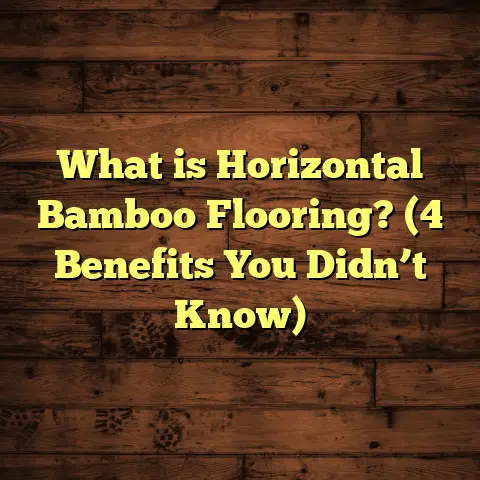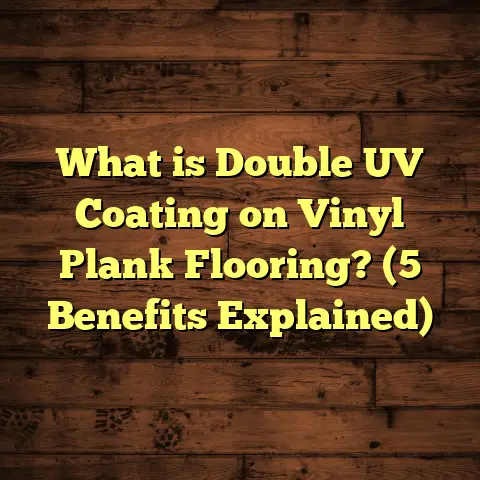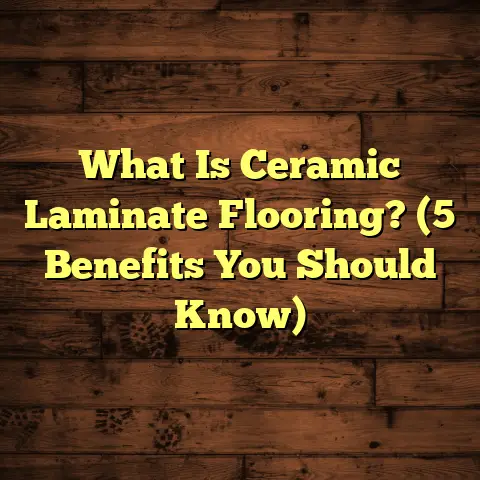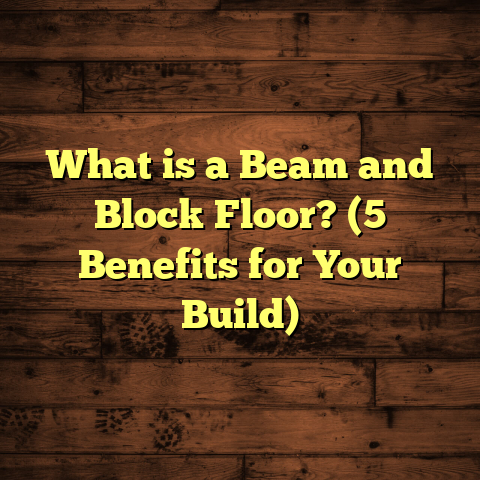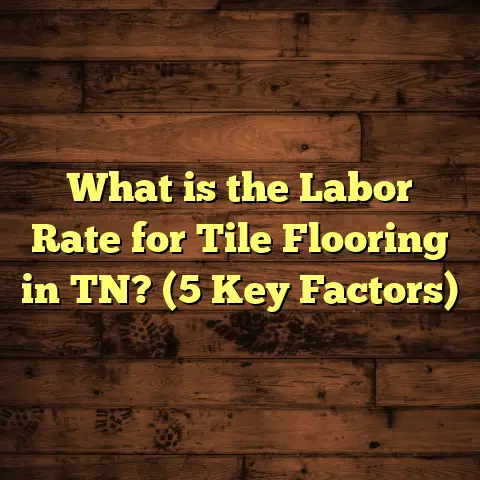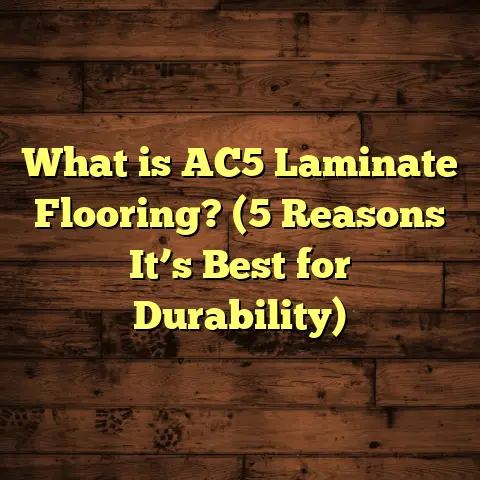What is Polyaspartic Flooring? (5 Benefits Explained!)
Noise is such a subtle but powerful factor in how comfortable a home feels. When I first started installing floors, I didn’t realize how much the right flooring could change the sound environment in a room. Hard floors like tile or polished concrete often create echoes and reverberations that make spaces noisy and less relaxing. On the other hand, some surfaces absorb sound better, reducing noise and making rooms more pleasant.
That’s where polyaspartic flooring caught my attention. It’s not just about durability or looks; polyaspartic floors help with noise reduction, especially compared to bare concrete or traditional epoxy coatings. If noise bothers you or you want a quieter, more peaceful space, polyaspartic floors are worth considering.
What Is Polyaspartic Flooring?
Polyaspartic flooring is a type of resin-based floor coating derived from polyaspartic esters, which are a subtype of polyurea. This chemical composition creates a fast-curing, highly durable flooring surface that can be applied in thin layers but offers excellent protection and aesthetics.
In practice, polyaspartic flooring is used as a protective and decorative coating over concrete or other substrates. It’s very popular in garages, commercial spaces, warehouses, retail stores, and even residential areas that demand both style and function.
How Does Polyaspartic Flooring Differ From Other Coatings?
I’ve worked with epoxy and polyurethane coatings for years, and polyaspartic stands out in several ways:
- Curing Speed: Polyaspartics cure in 2 to 4 hours under normal conditions, whereas epoxy can take 24 to 72 hours to fully cure.
- UV Resistance: Unlike epoxy, which yellows with sun exposure, polyaspartic maintains clarity and color stability outdoors.
- Flexibility: Polyaspartics are more flexible than epoxy, helping prevent cracks caused by substrate movement.
- Chemical Resistance: Polyaspartics resist chemicals just as well as epoxy but without the brittleness.
- Low VOCs & Odor: Polyaspartics emit fewer volatile organic compounds and have low odor during application.
The Chemistry Behind It
Polyaspartics are formed by the reaction of an isocyanate component with a resin blend containing polyaspartic esters. This reaction creates a polymer film that bonds tightly to surfaces. Because the reaction is fast and exothermic (gives off heat), the coating cures quickly without needing external heat or catalysts.
This fast curing benefits installations because it reduces downtime for businesses or homeowners.
My Journey With Polyaspartic Flooring
I remember the first time I installed polyaspartic flooring on a commercial project. The client was frustrated with epoxy floors that cracked and yellowed after exposure to sunlight through skylights. I suggested polyaspartic as an alternative.
The installation took less than a day. The floor looked glossy and smooth afterward—and best of all, it stayed strong and beautiful even after months of heavy foot traffic and sun exposure. That project opened my eyes to how versatile and practical polyaspartic coatings can be.
Since then, I’ve applied polyaspartic floors in homes, warehouses, restaurants, and even art galleries. Each time, I see clients impressed by how quickly we finish and how well the floor holds up.
5 Benefits of Polyaspartic Flooring Explained
Let’s explore five major benefits that make polyaspartic flooring a winner in many projects.
1. Fast Installation and Minimal Downtime
Time is money, right? In every project I’ve done, speed matters. Polyaspartic coatings cure so quickly that you can walk on them within hours.
For example, I worked on a local boutique that needed new floors without shutting down for days. With polyaspartic flooring, we finished installation before noon and reopened by evening. Customers didn’t even notice there had been work done!
This quick turnaround is great for businesses but also perfect for homeowners who don’t want to live without floor access for days.
2. Durability That Lasts
Durability is key for any flooring. Polyaspartics resist abrasion, scratching, impact damage, and stains better than many other coatings.
According to tests (ASTM D4060), polyaspartics have abrasion resistance up to five times better than epoxy. I saw this firsthand in an automotive workshop where heavy tools regularly dropped on the floor—no chips or cracks after two years.
They also hold up well to chemicals like oils, acids, and solvents. For industrial environments or garages exposed to spills, this is a huge advantage.
3. UV Resistance Means No Yellowing
One of the biggest complaints about epoxy floors is yellowing when exposed to sunlight. Polyaspartic coatings don’t have this problem.
I installed polyaspartic floors in a sunroom with large windows where epoxies previously failed due to discoloration. After years of bright sunlight exposure, the floor still looks clear and vibrant.
This makes polyaspartics ideal for outdoor patios or spaces with lots of natural light.
4. Low Odor and Environmentally Friendly
When installing floors indoors, especially homes or schools, odors from chemicals can be a dealbreaker.
Polyaspartic coatings release very low VOCs and have almost no smell during application. I remember working on a daycare center where parents were concerned about fumes. With polyaspartics, the facility reopened quickly with no complaints about air quality.
It’s also worth noting that many manufacturers offer low-VOC formulas that comply with strict environmental regulations.
5. Customization Options for Every Style
Floors don’t just need to be functional—they should look good too. Polyaspartics offer many options for color tinting and decorative flakes that create textured effects or sparkle.
I once mixed metallic pigments into a polyaspartic floor for a kitchen renovation project. The shimmering finish gave the space a modern yet warm vibe that guests still compliment years later.
With polyaspartics, you get glossy or matte finishes and can add anti-slip additives to improve safety without compromising looks.
Detailed Case Studies From My Projects
I want to share some real-world examples that highlight what polyaspartic floors can do:
Case Study 1: Commercial Kitchen Flooring
A restaurant needed new flooring that could withstand constant foot traffic, grease spills, and heavy cleaning.
Epoxy floors had peeled repeatedly due to heat and chemicals. We switched to polyaspartic flooring because of its chemical resistance and flexibility.
After 18 months, the floor remained intact with no peeling or staining. Staff reported it was easier to clean and quieter underfoot compared to previous floors.
Case Study 2: Residential Garage Transformation
A homeowner wanted a garage floor that looked modern but could handle cars, tools dropping, and occasional spills.
We installed a polyaspartic coating with decorative flakes for traction and aesthetics. The client loved how fast it dried—she parked her car on it by evening!
Two years later, the floor has held up beautifully with no chips or fading despite heavy use.
Case Study 3: Retail Store Flooring
A small retail store needed quick renovation without closing for days. We applied polyaspartic flooring overnight.
The store reopened the next morning with a smooth, shiny surface that impressed customers. The owner appreciated the noise reduction since foot traffic no longer echoed loudly.
Common Questions I Get About Polyaspartic Flooring
How Long Does Polyaspartic Flooring Last?
With proper installation and care, polyaspartic floors can last 10+ years without repairs. Many commercial spaces report longevity beyond this thanks to their durability.
Can Polyaspartics Be Used Outdoors?
Yes! Their UV resistance makes them suitable for patios, porches, and other outdoor applications where sunlight is a concern.
Are They Slippery?
The base finish is smooth but not dangerously slippery. For wet areas or where traction is important, adding anti-slip additives is recommended.
How Do You Maintain Polyaspartic Floors?
Maintenance is simple—regular sweeping and occasional mopping with mild detergent keeps them looking new. Avoid harsh chemicals or abrasive cleaners which can dull the finish over time.
Practical Tips From My Experience
- Always prepare the surface properly—clean thoroughly and remove any moisture.
- Use professional grinders or shot blasters on concrete surfaces before applying.
- Follow manufacturer temperature guidelines to avoid curing issues.
- If you want color customization, order pre-tinted kits or work with your installer closely.
- Consider your traffic type—add anti-slip features for wet or oily environments.
- Schedule installation during times when quick curing can minimize downtime.
- Don’t ignore warranty details; reputable manufacturers often back their products strongly.
Comparing Polyaspartic Flooring With Other Popular Options
Here’s how polyaspartics stack up against other common floor coatings:
| Feature | Polyaspartic | Epoxy | Polyurethane | Concrete Sealer |
|---|---|---|---|---|
| Cure Time | 2-4 hours | 1-3 days | 12-24 hours | Minutes to hours |
| UV Resistance | Excellent | Poor (yellowing) | Good | Moderate |
| Durability | Very High | High | Moderate | Low |
| Chemical Resistance | High | High | Moderate | Low |
| Odor During Install | Low | Strong | Moderate | Low |
| Customization | High | Moderate | Moderate | Low |
| Noise Reduction | Good | Moderate | Moderate | Poor |
This table reflects what I’ve learned over years of installing different floors—polyaspartics offer an impressive balance of speed, durability, appearance, and user-friendly attributes.
Environmental Impact Considerations
Many people ask about eco-friendliness when choosing flooring options. Polyaspartics have lower VOCs than epoxies and polyurethane coatings, which means they contribute less to indoor air pollution during installation.
Additionally, because of their durability and long lifespan, they reduce waste from frequent repairs or replacements—a win for sustainability.
Some manufacturers produce formulas meeting LEED certification criteria and other green building standards if environmental factors are important to you.
What Kind of Spaces Benefit Most From Polyaspartic Flooring?
Based on my experience:
- Garages: Handling vehicle traffic, oils, and spills.
- Restaurants & Commercial Kitchens: Chemical resistance and easy cleaning.
- Retail Stores: Quick installation minimizing downtime.
- Residential Basements & Sunrooms: UV stability and noise reduction.
- Warehouses & Workshops: High durability under heavy machinery.
- Healthcare Facilities: Low odor & easy sanitation.
- Outdoor Patios: UV resistance & weather durability.
Ask yourself what your top priorities are—is it speed? Durability? Appearance? Noise control? Polyaspartics often hit multiple marks at once.
How Much Does Polyaspartic Flooring Cost?
Cost varies depending on location, floor size, surface prep needs, and customization options. On average:
- Basic polyaspartic coatings range from $4 to $7 per square foot.
- Decorative options with flakes or metallic pigments can go up to $10-$15 per square foot.
- Surface preparation like grinding adds around $1-$3 per square foot depending on condition.
- Professional installation labor costs vary but typically add $2-$5 per square foot.
Compared to epoxy floors ($3-$6 per sq ft), polyaspartics are generally more expensive upfront but may save money long-term due to durability and less downtime during installation.
Final Thoughts From My Floor Installations
Polyaspartic flooring has become one of my favorite materials because it blends practicality with beauty. It’s a solution that solves common problems like noise reduction and yellowing while delivering fast results clients appreciate.
Whether you’re renovating a garage or outfitting a commercial space, considering polyaspartic coatings might just be the best choice you make for your floors—trust me on this one!
If you want advice specific to your project or want me to help estimate costs based on your space size and needs, just ask! I’m always happy to share what I’ve learned from years on the job.
